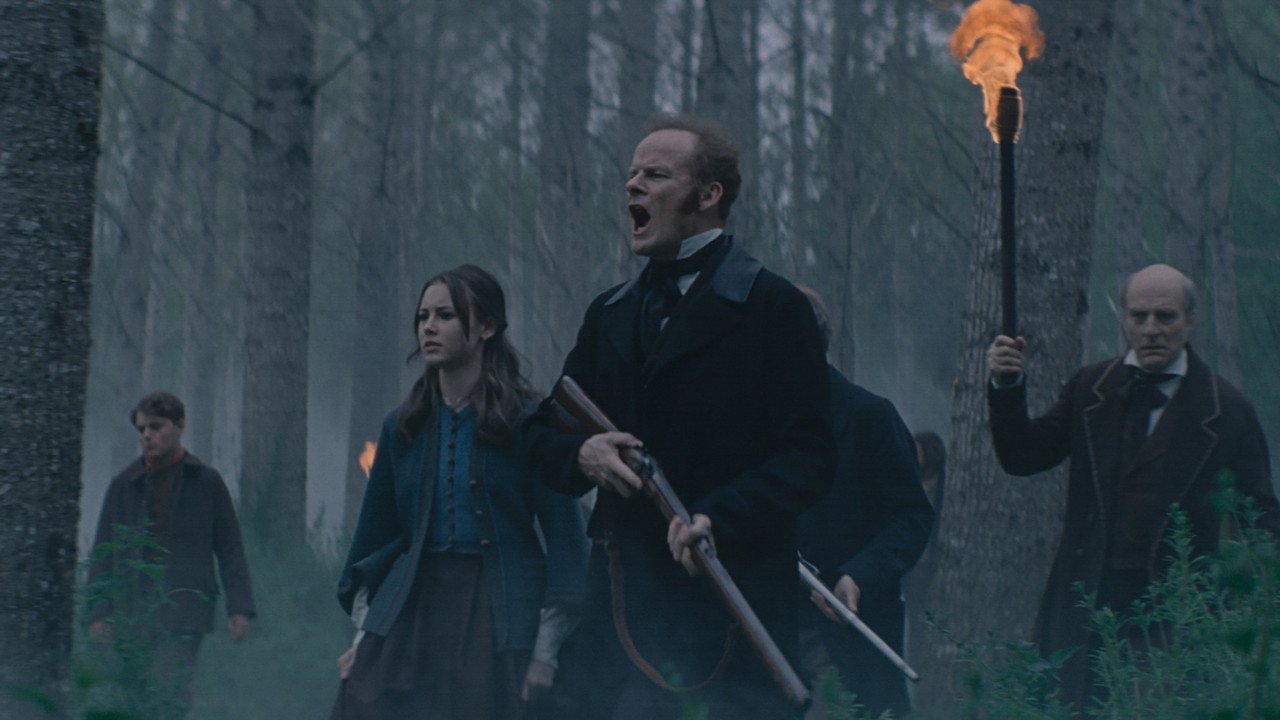The Cursed: Gothic Werewolf Period Piece Delivers Atmosphere With Fright
By Thom Ernst
Rating: B
When The Cursed played Sundance back in January 2021, it was called Eight for Silver, a clunky title even if limited to a mere three words. As a title, The Cursed is not much better, only less clunky and more transparent to the nature of the film, that of an early 19th-century French village plagued by the curse of a murdered woman, the last survivor of a massacred caravan of Roma settlers.
I have no recourse for feeling that The Cursed would be a hard sell for a Sundance audience other than that director Sean Ellis' independent spirit seems dampened by its larger-than-genre theme and a strangely (and sadly) downplayed homage to Hammer films.
Then again, The Cursed does have the load-bearing likeness of Sundance premieres that carry the marker of high-end horrors such as Hereditary, The Babadook, and its most apparent match, The VVitch.
Outside of Sundance, The Cursed would pair perfectly well with Jim Cummings’ The Wolf of Snow Hollow and even better with Christophe Gans’ Brotherhood of the Wolf.
As presented in capsules and press releases, it seems the filmmakers would have preferred to shroud their story in uncertainty. Has a supernatural curse unleashed bloodshed among the innocent villagers? Or are the attacks the responsibility of a very earthbound creature?
But the possibility that the beast may or may not be an otherworldly menace is barely in question and likely accounts for the title change. Besides, there seems to be no such commitment to secrecy coming out of Sundance, where all reports uphold the werewolf narrative.
The Cursed is a werewolf story. It might — and probably does — serve allegorical purposes as a way of speaking against intolerance. It might even be a cautionary tale about the spread of viruses or simply a morality cue on the outbreak of paranoia.
But whatever concealed intentions the film might have, The Cursed is, foremost, a werewolf story. And it's a werewolf story that marks its territory with familiar tropes while countering traditional mythology. There are no Howling-like transformations and gone is the despairing look of Lon Chaney beneath a full moon.
Ellis opens the film after a brief epilogue involving a wounded soldier in a World War I surgical tent (a horror itself), with a land baron's fateful and hastily arrived decision to drive a band of Roma peoples from his land. In his determination to set a lasting impression, the band is massacred.
Ellis reveals the massacre in a continuous shot from a short distance, where the rhythmic rise and fall of voices, stern, then challenging, then pleading, are heard but remain a strain when trying to decipher the words. The needless execution of the caravan leads to a curse that first invades the dreams of the villager's children, leading them to a buried talisman that awakens a more tangible nightmare.
This is not a gentle film, but neither is it excessive. The violence is severe but quick, and except for the opening massacre and a subsequent, gruesome but entirely compelling crucifixion, nothing is too hard to watch. The choices in the movie side with atmosphere over fright, despite a few curiously executed jump scares. Otherwise, The Cursed survives on the dramatic play between the land barons and a visiting pathologist, John McBride (Boyd Holbrook), with his own dark issues.
McBride enters the community with first-hand knowledge of the beast. His arrival at the village inn is met with textbook suspicion. But McBride has lived through hell and is not easily shaken. In movies gone by, McBride would be played by Peter Cushing, with Christopher Lee stepping in as the despicable land baron Seamus Laurent (here played by Alistair Petrie). Both characters fulfill their roles with the requisite amount of puritanical irony, rage, and grave determination.
There is much here to admire, not the least of which is Ellis' cinematography capturing the dank, vacant expanse of a 19th-century rural community. And a supporting cast that includes Kelly Reilly as Laurent's village-bound/house-bound wife, Roxane Duran as Anais, their docile housekeeper, and the Laurent children, Charlotte (Amelia Crouch) and Edward (Max Mackintosh), round out the film's layered measures of hope, fear, and frustration.
But the film stops short of being excellent. The Cursed never manages to match the intensity set-up in its opening scenes. And the promise of the vintage Hammer-style horror it seems to want to emulate is quickly forgotten.
Either Ellis had hoped to turn the genre on end, or he lost faith that contemporary audiences would buy into his gothic vision. This will disappoint those who prefer their werewolves with teeth. Still, The Cursed rises above most standards set by the genre.
I only wish I could say it was a Howling success.
The Cursed. Directed by Sean Ellis. Starring Boyd Holbrook, Alistair Petrie, Kelly Reilly, Roxane Duran, Amelia Crouch, and Max Mackintosh. Opens in select theatres February 18.
February 16, 2022Horror, Sundance films, The Cursed, Sean Ellis, Alistair Petrie, Kelly Reilly, Roxane Duran, Amelia Crouch, Max Mackintosh, Boyd Holbrook


